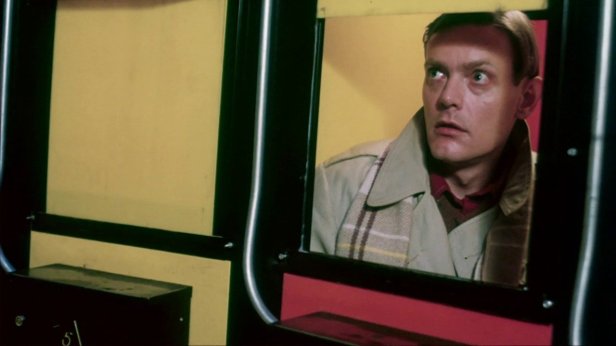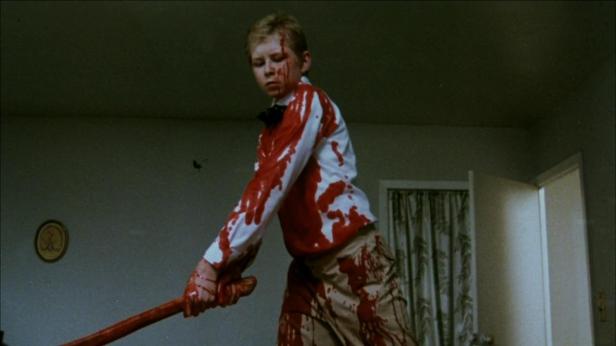Nico Mastorakis’ Island of Death may have the greater catalogue of perversities but Romano Scavolini’s brutal Nightmare (released and banned in the UK as Nightmares in a Damaged Brain) is arguably the nastiest of the “video nasties” thanks to some particularly impressive gore effects whose parentage has proved contentious over the years. It was also the film at the centre of possibly the most shameful moment in the entire “video nasties” debacle.
The film itself is a rather muddled affair, a slasher that suffers from an interminable mid-section where nothing much happens. It begins well, with George Tatum (Baird Stafford), a psychiatric patent in New York, suffering a horrific nightmare of a violent incident from his childhood that ends with a woman being decapitated. George is part of an experimental programme seemingly inspired by the Ludovico technique from A Clockwork Orange (1971) using pioneering drugs to reprogram his brain. His doctors think that the procedure has been a success and allow him to go free – and you don’t have to have seen many horror films to work out where this might be going…

Sure enough, George slips the surveillance of his medical team and heads off to Florida where his ex-wife Susan (Sharon Smith) and his children Kim (Kim Patterson), Tammy (Tammy Patterson) and annoying, practical joke playing son C.J. (C.J. Cooke).are shacked up with Susan’s new boyfriend Bob (Mik Cribben – shaggy haired, bearded and sporting a red bandana; you’ll swear you’ve seen this guy in a dozen or more late 70s and early 80s horror films). Still suffering those terrible nightmares, an increasingly unhinged George embarks on a killing spree as the precocious C.J. muddies the waters with his inane stunts.
Where Nightmare scores is in its resolutely grimy depiction of some of the sleazier quarters of New York. George visits a strip joint where a near-the-knuckle encounter with a sex worker (likely as much a problem for the authorities as the gore) triggers violent flashbacks and causes George to fit and inexplicably start frothing at the mouth. Elsewhere, run-down bars are full of sad, lonely people and the streets are teeming with hookers, pimps and assorted ne’er-do-wells. These opening scenes are commendably grubby and the film suffers somewhat when it moves to the sunnier climes of Florida and George spends far too long lurking around Sharon’s house while Scavolini focuses on the not terribly exciting family drama unfolding in Sharon’s home.

It picks up a bit towards the end when George dons one of C.J.’s masks and decides to make short work of the children’s babysitter Kathy (Danny Ronan) with a rock pick before menacing the children. A ridiculous final shot suggests that C,J, is now experiencing his father’s flashbacks (it turns out that it was a young George who murdered the woman who he’d caught in a sadomasochistic tryst with his father) and as he winks knowingly at the camera, one is left with the suggestion that he’s about to step into dad’s murderous shoes.
None of this really adds up to very much and it’s the gore scenes that are both the films only real draw and the source of many of its woes. When it was first released in the States, the producers played up the “fact” that make-up effects guru Tom Savini had provided the film’s nastier moments. But Savini contested the claim, initially claiming that he had nothing to do with the film at all though the subsequent appearance of photographs of him on the set led to him admitting that he had been there when some of the gore effects were filmed, though only in an advisory capacity. He claimed that he passed on the project when offered it and suggested Ed French instead. Whoever was responsible for them, they’re among the grisliest and most realistic effects scenes in any of the “video nasties”, the rock pick murder and a graphic throat slitting in particular being horribly memorable.

They were certainly effective enough to attract the ire of the UK authorities. The film had played UK cinemas in 1982 with many cuts inflicted by the British Board of Film Censors who shortened the aforementioned throat slitting, made reductions to the killing of Kathy and truncated the climactic flashback to George killing his father and his lover. When the film arrived on video in May 1982, in a still cut version but one that was till longer than the BBFC approved version, it was released by World of Video 2000, a company set up by British pornographers David Hamilton Grant and Malcolm Fancey, son of one of Britain’s most prolific film producer/distributors, Edwin J. Fancey, as a video outlet for films released to UK cinemas through their Oppidan company. When they released Nightmare, under its Nightmares in a Damaged Brain title, the company immediately courted controversy when they promoted it with a competition to guess the weight of a prop human brain preserved in a jar – the participants in the competition being patients in a Surrey hospital. The police were called by horrified medical staff, the “brain” confiscated and the film and its distributors were targeted by the authorities. Within days, their London offices were raided and copies of Nightmares in a Damaged Brain seized.
This was getting to be an occupational hazard for distributors of violent horror films in the UK at the time but what happened next was unprecedented and marked the lowest point in the whole “video nasties” fiasco. As the hysteria about the supposed effects that these films were having, particularly on children, Grant became the campaign to ban them’s scapegoat and he was prosecuted for “possession of over 200 copies of an obscene article for publication for gain.” Found guilty under section two of the Obscene Publications Act, Grant was sentenced to 18 months in prison (later reduced to 12 months) when he refused to cut the film, becoming the only person to be jailed during the whole sorry affair.

It was a strange hill for Grant to choose to “die” on – though Nightmare has an impressively grotty ambience and some suitably shocking gore, it’s certainly not a great film that needed Grant to martyr himself over. The centre section is tedious, the production often amateurish and that most wearying of slasher cliches – the killings or moments of threat that turn out to be a practical joke – is annoyingly front and centre throughout. There’s also a whiff of pretentiousness about it, Scavolini dabbling in Freudian themes that he notably fails to develop in any interesting way. The Nightmares in a Damaged Brain version was even pompously introduced by a title card reading “Scaolini’s Nightmares in a Damaged Brain“, as if anyone knew who he was at the time – or even cared come to that. Grant’s “sacrifice” was made even more ridiculous when, in 2015, an uncut version was passed untouched by the BBFC.